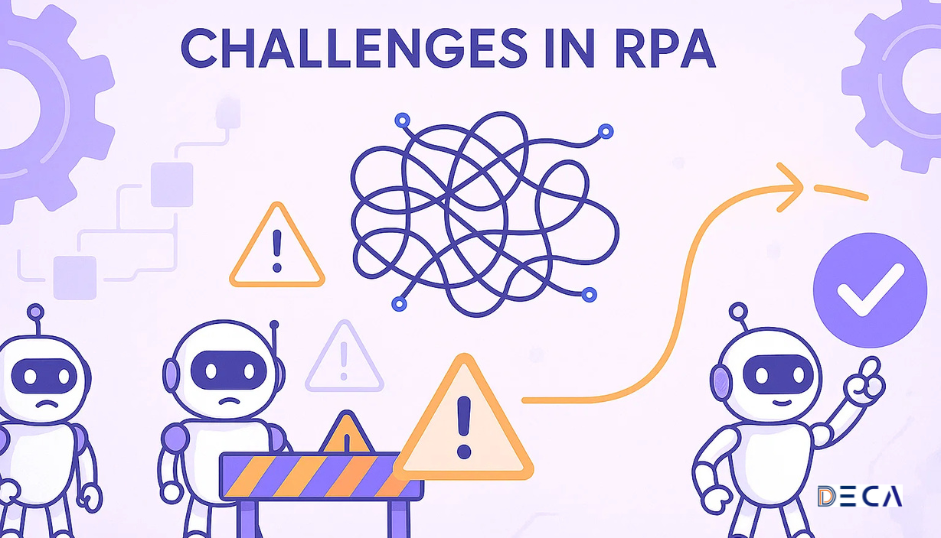Top Challenges in RPA Implementation (and How to Overcome Them in 2025)

Robotic Process Automation (RPA) has transformed from a niche enterprise technology into a mainstream business enabler. Today, organizations of all sizes are leveraging RPA to streamline operations, reduce costs, and improve accuracy. Analysts predict that the global RPA market will surpass $30 billion by 2030, with adoption accelerating across industries.
But here’s the reality: while businesses are eager to automate, many struggle when it comes to execution. According to the Global RPA Survey, 30–50% of RPA projects fail to scale or deliver expected ROI, often due to poor process selection, governance issues, integration hurdles, or resistance from employees.
This blog explores the top challenges in RPA implementation and practical solutions for 2025. Whether you’re a small business just starting out or a large enterprise aiming to scale, addressing these challenges will determine whether your RPA journey succeeds or stalls.
👉 If you’re looking for a detailed roadmap, check out our guide on How to Implement RPA in Your Business.
Challenge #1: Poor Process Selection
One of the biggest reasons RPA projects fail is automating the wrong processes. Businesses often attempt to automate workflows that are too complex, unpredictable, or require heavy human judgment.
Examples of poor process selection:
- Processes with inconsistent inputs (e.g., handwritten forms).
- Workflows with frequent exceptions or irregular rules.
- Tasks dependent on subjective decision-making.
✅ Solution: Use Process Mining and Start Small
Instead of guessing, leverage process mining and discovery tools to analyze how tasks are performed. Look for processes that are:
- Repetitive (same steps each time).
- High volume (large transaction counts).
- Rule-based (clear logic with few exceptions).
- Stable (systems and rules don’t change often).
By starting with one or two simple, high-impact processes, businesses can demonstrate quick wins and build confidence in RPA.
Challenge #2: Lack of Executive Buy-In
RPA requires not just technology, but organizational alignment. Without support from senior leadership, projects often stall due to lack of funding, prioritization, or cross-department collaboration.
Signs of weak buy-in:
- RPA seen as an “IT experiment” rather than a business initiative.
- No clear owner for automation strategy.
- Budget cuts before scaling.
✅ Solution: Build a Business Case and Show ROI Early
To gain leadership support:
- Quantify ROI in terms of cost savings, time saved, and error reduction.
- Start with a pilot project that demonstrates tangible results.
- Align RPA with strategic goals (customer experience, compliance, scalability).
When executives see measurable impact, they’re more likely to champion automation at the organizational level.
Challenge #3: Resistance from Employees
A common misconception among employees is that RPA will “replace their jobs.” This fear often leads to resistance, lack of cooperation, or even sabotage of RPA initiatives.
Why employees resist:
- Fear of redundancy.
- Lack of understanding of automation’s purpose.
- Concern about learning new technologies.
✅ Solution: Position RPA as an Assistant, Not a Replacement
The key is communication. Businesses must clearly convey that RPA eliminates repetitive, mundane tasks, allowing employees to focus on strategic, creative, and customer-facing work.
Additional best practices:
- Conduct training sessions on RPA benefits.
- Involve employees early in process selection.
- Highlight success stories of employees freed from tedious work.
Challenge #4: Scaling Bottlenecks
Many organizations succeed with pilot projects, but fail when trying to expand automation enterprise-wide. The result: isolated “pockets of automation” instead of company-wide transformation.
Why scaling fails:
- No governance framework.
- Lack of standardized best practices.
- Tools not scalable across departments.
✅ Solution: Establish an RPA Center of Excellence (CoE)
A CoE provides governance, best practices, and consistency across automation projects. Its responsibilities include:
- Defining automation standards.
- Selecting tools and vendors.
- Managing compliance and security.
- Tracking ROI across the organization.
By centralizing strategy and resources, businesses can avoid duplication and accelerate scaling.
Challenge #5: Integration with Legacy Systems
RPA bots often need to interact with legacy applications that lack APIs or modern integration options. This leads to fragile automations that break with minor UI changes.
Example:
An RPA bot built to extract data from a green-screen mainframe can fail if the screen layout changes slightly.
✅ Solution: Choose Tools with Strong Integration Capabilities
To minimize issues:
- Select RPA tools with native connectors for popular systems (ERP, CRM, HR).
- Use API-first integration wherever possible.
- Build error-handling logic into bots.
Modern tools like UiPath, Power Automate, and Workato offer hybrid integration (RPA + APIs), making bots more resilient and future-proof.
Challenge #6: Governance and Security Issues
Without proper oversight, RPA implementations can expose organizations to compliance risks and security vulnerabilities.
Common risks:
- Bots handling sensitive financial or personal data without audit trails.
- No version control or change management.
- Lack of access restrictions.
✅ Solution: Build a Strong Governance Framework
A governance model ensures RPA is secure, compliant, and sustainable. Best practices include:
- Assigning bot IDs and tracking all activity.
- Implementing role-based access control (RBAC).
- Maintaining logs and audit trails.
- Aligning with regulatory requirements (GDPR, HIPAA, SOC 2).
Challenge #7: Measuring ROI Incorrectly
Many businesses struggle to quantify RPA’s impact. Focusing only on cost savings ignores other benefits like error reduction, compliance, and employee productivity.
Problem with narrow ROI measurement:
- Automation may look unprofitable if only direct cost is considered.
- Intangible benefits (customer satisfaction, faster turnaround) are overlooked.
✅ Solution: Adopt a Broader ROI Framework
When measuring ROI, include:
- Time saved (hours freed for employees).
- Error reduction (improved accuracy).
- Customer impact (faster response times).
- Scalability benefits (reduced cost of future automations).
A holistic view helps justify RPA as a long-term investment, not just a cost-cutting tool.
👉 Want to dive deeper into ROI? Read our blog on How to Measure ROI from RPA and AI Projects
Future Outlook: RPA in 2025 and Beyond
The challenges of today are shaping the future of RPA. By 2025, the focus will shift from basic automation to intelligent hyperautomation.
Key trends to watch:
- AI + RPA: Intelligent bots capable of natural language processing and decision-making.
- Document Understanding: Automating unstructured data like invoices, contracts, and emails.
- Chatbot + RPA Integration: End-to-end customer service automation.
- Industry-Specific Bots: Prebuilt automations tailored for healthcare, banking, logistics, and more.
Organizations that adopt RPA with foresight—anticipating challenges and preparing solutions—will be better positioned to stay competitive.
Conclusion
RPA implementation isn’t just about choosing the right tool—it’s about managing change, governance, and scaling effectively. Businesses that fail to anticipate challenges risk stalled projects, wasted investment, and frustrated teams.
But the good news? Every challenge has a solution. By carefully selecting processes, building a business case, engaging employees, ensuring governance, and tracking ROI holistically, your organization can achieve automation success in 2025 and beyond.
At DecaSoft Solutions, we help businesses overcome these RPA implementation challenges. From process discovery to scaling automation enterprise-wide, our experts ensure smooth adoption and measurable ROI.
👉 Ready to automate smarter? Contact DecaSoft Solutions today to build a future-proof automation strategy.




